罗马与汉朝,谁的技术更加先进(3) [美国媒体]
quora网友:军事科技:罗马军队至今仍然世界闻名,拥有28个高度致命且专业的强大军团,大约由14-16.8人万组成;被授命捍卫大罗马帝国500万平方公里的土地。同样,罗马在军事领域的创新不容小觑。罗马人以使用各种不同类型的攻城器械而闻名.......
Whichwas more technologically advanced, the Roman Empire or Han China?
罗马与汉朝,谁的技术更加先进?
Military Technology
The Roman Military still to this very day, was a world renowned,highly lethal and professional 28 Legions strong force, comprising of roughly140–168,000 men; a given in order to defend the 5 million km^2 land area of thevast Roman Empire. Naturally as such, Roman innovations in the fields of theMilitary cannot be underestimated.
The Romans were known to have used a great variety of siegeengines. Onagers for one, similar to catapults were torsion powered (twistingof an object due to applied torque) consisting of a single vertical beam thrusta thick horizontal skein of twisted cords. Its skein meanwhile was subsequentlytwisted tight by geared winches, the beam was then pulled down to assume ahorizontal position. This acted to further twist the aforementioned skein,whilst also increasing its torsion in addition.
An artist’s impression of a Roman Onager:
军事科技
罗马军队至今仍然世界闻名,拥有28个高度致命且专业的强大军团,大约由14-16.8人万组成;被授命捍卫大罗马帝国500万平方公里的土地。同样,罗马在军事领域的创新不容小觑。
罗马人以使用各种不同类型的攻城器械而闻名。其中一种叫“Onagers”,类似于弹射器,由扭力驱动(由施加的扭矩引起的物体扭曲),包括一件单垂直梁,和一根很粗的水平绞线。首先,绞线被绞车绞紧,然后垂直梁被拉下来呈水平位置。这样就进一步扭曲了绞线,同时还增加了其扭力。
一张关于罗马Onager(攻城器械)的画作:
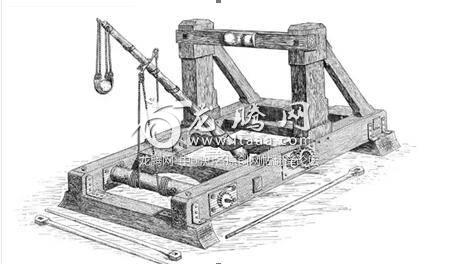
A stone was then placed on the end of the an Onager’s sling, andhurled either into a city’s walls, or straight into the enemy’s ranks when thebeam was freed of its restraint and rebounded violently back to its originalvertical position.
Onagers were not the only siege weapons to be utilized by theRomans however, Ballistas or large scale bolt throwers were also used to a hugeextent during the Imperial Era. The largest ballistas were quite accurate, andcould hurl both huge and heavy projectiles up to 460 metres away. It couldmeanwhile even accommodate weights of up to 30 kg. Weights of up to 78 kg werenot unheard of however.
Ballistas much like Onagers, were also torsion powered but hadtwo sets of parallel skeins instead through which 2 separate arms joined attheir ends by the cord that propelled the missile. Ballistas were also muchsmaller than Onagers usually, allowing them to be more readily operated.Repeating ballistas in addition also existed, but were used on a scale muchsmaller than any of their standard variants. On the rare occasions that theywere used however, they could fire up to several bolts without having the needto reload.
A reconstruction of a large scale Roman Ballista:
接着,在Onager弩炮的尾部吊索上安放一块石头,然后将石头猛投至敌军城墙上,当条件允许的时候,还可直接将石头投至敌军阵营中。投完石头之后,垂直梁会猛烈弹回至垂直位置。
Onagers弩炮并不是罗马人唯一使用的攻城器械,在罗马帝国时代,Ballistas弩炮或大型锚杆投掷器也被大量使用。最大的Ballistas弩炮相当准确,可以将又重又大的射弹投掷460米远。甚至可以容纳重达30公斤的重物。不过,重达78公斤的也并非闻所未闻。
Ballistas弩炮很像Onagers,也是扭力驱动的,但是配有两组平行绞线,而两根单独的臂在尾部连接到推动炮弹的绳索。Ballistas型弩炮通常比Onagers小得多,也更容易操作。另外还有可连续发射的ballistas型射炮,但使用的规模比标准型号要小得多。
大型罗马Ballista型弩炮重建:

A smaller projectile accelerator known as the Scorpionmeanwhile, were also utilized during the Imperial Era. Functioning verysimilarly to a Roman Ballista, Scorpions were usually placed at the top of ahill on the sides of an accompanying Roman legion. When shot from an elevatedposition, distances of up to 400 metres could easily reached by the resultingfired bolts from a Scorpion.
With a fire rate of 4 bolts/minute, more often than not theScorpion was also used for long range defence rather than offense as it wasusually quite difficult to move. It was also extremely expensive in addition,and was said to be essentially an overly large crossbow. 60 Scorpions perLegion was the norm during the Late Republic and Early Empire Era.
A reconstruction of a Imperial Roman Scorpion:
同时还有一种较小的炮弹加速器在罗马帝国时代也有使用,人称“蝎子”。与罗马弩炮功能十分类似,“蝎子”通常被安置在罗马军团两侧的山顶上。当从较高的位置射击时,“蝎子”所发射栓子可以轻松达到400米的距离。
一分钟能发射4只炮弹,“蝎子”常常用于长距离防守而不是进攻,因为通常很难移动。另外造价十分昂贵。据说其本质上是一座弩。不过每个军团都配有“蝎子”,这在罗马共和国末期和罗马帝国早期时期是常态。
罗马帝国“蝎子(一种射炮加速器)”重建:
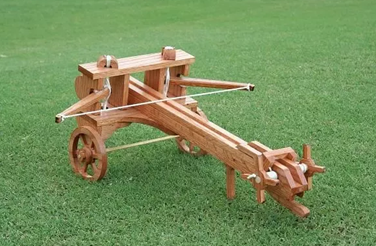
And of course as mentioned earlier, the Romans had a verysophisticated system of military surgeries, and also actively utilized pontoonbridges to suppress their enemies.
Ships were tied together side by side to allow a temporarycrossing for the army, to journey across a particular dangerous section of ariver or lake. The speed at which such crossings were made, was also perfectedduring the Imperial Era allowing the Romans to often catch their enemies offguard. Rafts were however were usually used more than pontoon bridges though,since they were easier to construct and deconstruct.
Every Roman legion meanwhile at any given time was alwaysaccompanied with a battlefield surgery unit (an innovation first pioneered bythe Romans).
The Romans were also well acquainted with fort building inaddition, and due to the fact that every last single Roman Legionary wastrained in the arts of structural engineering, could build high quality fortsas required, in a supernaturally short amount of time.
Reconstruction of the gateway of Arbeia Fort:
当然了,就像前文所述,罗马拥有复杂的军用手术系统,并经常利用浮桥来压制敌人。
船舶并排在一起,以便让军队临时穿越河流或湖泊等危险区域。在罗马帝国期间,这种方式的渡河速度也十分令人满意,如此一来,罗马人经常可成功将他敌人赶走。然而,通常还是使用木筏而不是浮桥,因为木筏更容易构建和拆卸。
此外,罗马人还非常擅长建造堡。而且,由于每一个罗马军团的成员都接受过结构工程方面的训练,可根据需要,在极短的时间内建造高质量的堡垒。
Arbeia堡垒大门重建图:
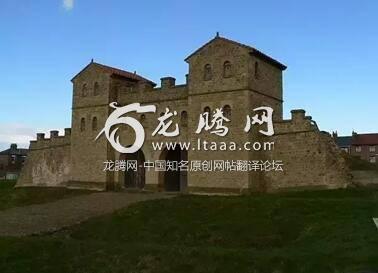
What made the building of Roman forts (Castra) especiallynotable, was the fact that a Legion could build one from scratch even after along day’s march, using the raw materials from their surroundings. Severalspecialist engineering units were formed just in order to concentrate on theconstruction of said structures, called “Immunes”, since they were excused fromthe normal duties usually required from an ordinary legionary.
Commandeered by an overseeing unit called the Architecti(Engineers), the immunes could even under the very worst of circumstances, havean emergency fort constructed in a matter of hours. Camp plans from textbookswritten specifically to aid in the construction of forts, were given to theArchitecti to continuously reference whilst building, and manual labour wasmandatory amongst legionaries to assist in the establishment of forts.
As for the forts themselves, every legion had in its possessionone which served as its de facto headquarters where they were repeatedlyrendezvous back at after a certain period of time. Much more so than theirtemporary forts, these main Castrum were highly sophisticated with regards totheir features.
A plan for a typical Roman Fort in Bavaria, Germany:
那么是什么让罗马的堡垒(Castra)建筑特别引人注目呢?那是因为军团可以在漫长的一天行军之后,使用周遭的原材料,从头开始建造一座建筑。军团中会成立几个专业的工程小分队,专门集中精力建造一种叫做“Immunes”的建筑。
这些小分队,由一个叫“Architecti”(工程师)的监督单位指挥,即使是在最坏的情况下,也可以在几个小时内建成一座紧急堡垒。为了协助建造堡垒,罗马的教科书上专门写有建造营地的内容,而工程师也可以不断参考书本的内容来实施建设,并且军队中的体力劳动是强制性的,以协助建造堡垒。
每个军团都拥有一个堡垒作为总部,他们会每隔一段时间后在堡垒里会面一次。罗马军队的主堡--“Castrum”,从建筑特性来说,要比临时堡垒复杂得多。
德国巴伐利亚州,典型罗马堡垒的图纸:
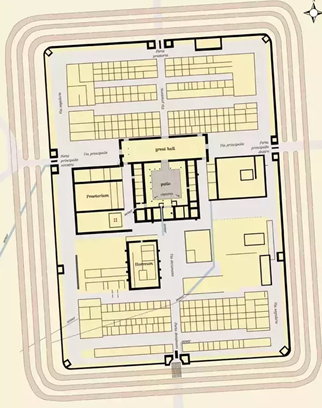
Castrums in any case always had a castellum (wall) of some sort,usually made out of stone if possible but apart from that were also aided bytrenches (fossa) which were filled to the brim with stakes (sudes). Possessinga rectangular exterior, towers were placed at regular intervals all along thesewalls armed with scorpions and other siege weapons.
As for Legionaries themselves meanwhile during the EarlyImperial Era, were fortunate enough to have in their possession 4 key Romanmilitary innovations: the Pilum, the Scutum, LoricaSegmentata and of course,the Gladius.
Coming in to variants; thick and thin was the Roman Javelin.Both types of pilum were roughly 2 metres long, but the thick variant wasattached to the shaft with a 5 cm wide tang. The tip of both versions howeverwas pyramidal in shape, with a diameter of 7.5 mm, and was directly above awooden block to not only secure the metal head, but also to protect one’s handin melee combat.
Both types of pilums were carried by an average warringlegionary. The way they operated however, was that the javelins would be tossedat the enemy prior to an infantry charge. If the javelins did not meet theirtargets, and landed on a hostile shield instead, the pilum’s tip was designedto break off, acting to substantially contribute to the weight of an enemy’ssafeguard, forcing him to part with it, making him especially vulnerable toattack.
The ingenuity of this design also meant that pilums could not beretrieved and thrown back at the legionaries themselves. They are depictedbelow as follows:
“Castrums(古罗马兵营)”通常配有或多或少的围墙,如果可能的话,通常由石头建成,除此之外,还可使用木桩填入边缘的壕沟建成围墙。通常会有一堵长方形的外墙,每隔一段距离都会安放“蝎子(射弹加速器)”和攻城武器。
罗马帝国早期,军团就拥有了4项重要的军事技术创新,包括:罗马短矛、罗马盾牌、罗马环片甲,当然了还包括罗马短剑。
至于短矛的变种兵器,那就是罗马的重标枪和轻标枪了。这两种短矛的长度大约在2米左右,但是重标枪会被连接到5厘米宽的抢柄上,两种标枪的顶端形状均为金字塔形,直径为7.5毫米,在木柄上方不仅可以固定金属枪头,而且在近战中还可用来保护士兵的手。
普通的战斗军团都装备有这两种短矛。但是,他们操作的方式是在步兵冲锋之前将标枪投向敌人。如果标枪没有刺中目标,而是落在敌人的盾牌上,那么标枪就会自行损坏,因为这种标枪就的这种独创性设计,如此一来,可以增加敌军盾甲的重量,迫使敌军增加负担,也是敌军更容易受到攻击:

Scutums on the other hand, were the standard rectangular shapedshields of utilized by the Roman Army all over the Mediterranean. Equipped withround edges that curved around the corners, the Scutum was a human sized shieldallowing a Roman soldier to effectively knock out cold an enemy warrior in somepotential cases, or severely put him off balance at least.
The iconic Roman shield was on average roughly 1 metre high, 40cm across, and 0.6 cm thick. Light enough to be held in one hand also, itallowed the vast majority of the 1.6–1.8 m tall legionary. Scutums most notablyalso allowed the Legions to form a variety of different formations includingbut not limited to standard shield tactics such as the famous Testudo orTortoise formation:
另外,另一方面,罗马盾牌是罗马军队在整个地中海地区使用的标准矩形盾牌。拥有圆角的边缘和弯曲的折角,罗马盾牌被做成人类的大小,在特定的情况下,罗马士兵可利用这种盾牌有效击昏敌军,或者至少打破敌人的身体平衡。
典型的罗马盾大于1米高、40里面宽,大约是0.6厘米的厚度。重量足够轻,易于手持,适合军团大部分1.6~1.8m的军人使用。最值得注意的是,罗马盾也允许军团形成各种不同的编队,包括但不限于标准的盾牌战术,如着名的的龟甲形攻城方阵编队:
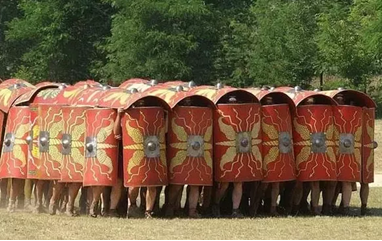
LoricaSegmentata on the other hand was considered to be Rome’s stateof the art classed body armour. Naturally as such, it was sometimes substitutedinstead for its chainmail counterpart; the LoricaHamata. In the still commoncases however where they did don a suit of the iconic 2nd Century Roman armour,it allowed its wearer to have several inherent advantages when it came tomatters of combat.
There were four sections to LoricaSegmentata, two for theshoulders and two for the torsos. Using a technique called “case hardening”,the Legionary’s standard armour simultaneously used soft iron on the insidewhilst also utilizing several strips of steel from without, attached togethervia the use of leather straps. The strips were arranged horizontally on thebody, overlapping downwards, and they surrounded the torso in two halves, beingfastened at the front and back.
A suit of LoricaSegmentata:
另外,罗马环片甲被认为是罗马的艺术级盔甲。自然的,有时候也会被锁子甲代替;不过,通常情况下,罗马军队都能穿上这种第二代罗马装甲。当开展战斗时,它能使穿戴者获得几项固有优势。
罗马环片甲由4个部分组成,其中2部分用于保护肩膀,另外两部分用于保护躯干。采用了一种人称“表面硬化”的技术,这种标准装甲在内部衬有软铁,在外部则采用了几根钢带,然后通过皮带将二者连接在一起。钢带水平放置于身上,向下重叠,将躯干分为两部分环抱起来,分别固定在前部和后部。
一套罗马环片甲:
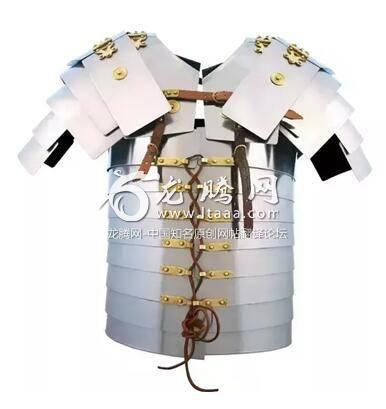
The shoulders meanwhile were safeguarded by additional steelplates which allowed for additional protection. This was a major disadvantagehowever, as it often meant that the armour weighed at least over 9 kg whichwould certainly have drowned its wearer should he have been unfortunate enoughto have fallen into a lake. It also corroded very easily.
Last but not least meanwhile was the Roman Gladius; a shortsword essentially. Made from steel, and only 60–85 cm in length with a weightmerely of 0.7–1 kg, the Gladius was a core part of the Imperial Roman Army.
The design was such that it was used to stab rather than slice,and was efficient especially when it came to fighting in close quarteredformations with little room for free moving nor mistakes:
与此同时,肩部也由额外的钢板保护。然而这是一个主要的缺点,因为它通常意味着装甲的重量至少超过9公斤,如果不幸坠入湖中,佩戴者肯定会被淹死。
最后要介绍的是罗马短剑。由钢制成,只有60-85厘米长,重量仅为0.7-1千克,罗马短剑乃是帝国军队的核心装备。
设计成下图那样,主要是用来戳刺而不是切削,特别是在近距离阵营对战时,由于自由移动空间较小、且战斗容错率较小的情况下,这种短剑是十分高效的:

In great contrast to the Romans, the Han Chinese had fewerdevelopments in the realms of military technology.
The Han Empire did however make good use of Crossbows. Crossbowshad of course already been around since the 6th Century BC, having beeninvented by the Ancient Chinese during the Spring and Autumn Period (771–476BC), but during the Han Empire saw new heights attained.
Crossbows during the Han Era were improved to such an extentthat entire Imperial corps trained specifically in the aforementioned weaponwere more than capable of completely (if not that, then at least mostly)decimating a group of mounted warriors, who had been charging from afar. Rows uponrows of Chinese crossbowman were formed, all properly trained to fire off asingle volley before ducking to allow the supporting row behind them to fireoff a another round of projectiles directly at the enemy.
A Han Era Crossbow:
与罗马人截然不同的是,汉朝人在军事科技领域的进展甚微。
但是汉帝国却十分擅长用弩。当然了,大约公元前6世纪弩就已经出现,由春秋时期(公元前771-476年)的古代中国人发明。但在汉帝国时期,弩的使用达到了新的高度。
弩在汉朝时期被改进到一种新的高度,整个帝国的军队都针对弩进行了特别的训练,这些部队可完全歼灭(如果不是完全歼灭也能歼灭大部分)一队从远处冲锋而来的骑兵。一排排受过良好训练的中国弩兵,前排的弩兵先进行一次齐射,接着躲闪到后排,后排接着向敌阵发起另一次齐射。
一把汉代军用弩:

One of the most common forms of Crossbowmen tactics was to splita division into two, in the form of two wings, in order to allow for crossfireto occur. Not only was it severely devastating to the opposition, it also actedindirectly as psychological warfare.
Not only did the Chinese use two types of crossbows (light andheavy), but they also took to mounted archery as well in addition, having beeninfluenced by their wars with the Turkic Nomadic Xiongnu Empire (209 BC-439AD).
, Single-handed crossbows in addition alsoexisted during the time period, which allowed for mounted riders to be holdonto the reins of the horses whilst shooting also.
Crossbows ended up being mass produced to such an extent infact, that in the city of Luoyang alone, a reported 11,181 crossbows and 34,625arrows have been discovered in the former Han secondary Capital alone.Repeating crossbows meanwhile during the Han Era, had also just been introducedfor the first time ever towards the end of Imperial China’s second dynasty.
The Chinese invention of the repeating crossbow, introducedduring the Han Era:
最常见的弩兵阵型,那就是将一个师拆分成两个部分,布置在军团两翼,以方便迎战。这样不仅可对敌军派造成严重破坏,而且还可间接地作为心理战术
中国人不仅使用了2种弩(轻型弩与重型弩),由于受到与游牧民族--匈奴帝国(公元前209年~公元439年)的战争影响,他们还额外配备了骑射部队。
在汉代时期,还存在着单手弩,这使骑射兵在射击的同时还能抓住马缰。
最终,弩被大量生产使用到了一种新的高度,事实上,单单在西汉陪都--洛阳城就发现了11181具弩以及34625把弓箭。同时,在汉朝第二王朝的末期,还首次发明了连弩。
以下是中国人发明的连弩,出现于汉朝时期:
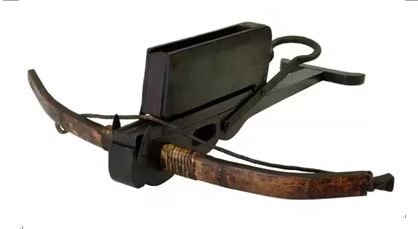
Invented by a Han strategist named Zhuge Liang (who alsoinvented the Kite as previously discussed), the Repeating Crossbow had a muchhigher rate of fire than its more normal variants, because the act of stringingthe bow, placing a bolt and shooting it could all be done with one hand whilst keepingthe weapon stationary.
To make it work, a “magazine” containing a number of bolts wasloaded into the crossbow, and as the projectiles were being fired, it triggereda mechanism from within which would cause a rectangular level to oscillatebackwards and forwards appropriately. Weighing merely 1.19 kg, 0.6 m in length,0.44 m in width and also extremely easy to produce and operate, it gave the HanChinese a massive edge on the battlefield.
Horse drawn, “Heavy Crossbows” (武刚车) were alsoknown to be used in sieges, with one particular variant requiring theequivalent of 159 kg to even load. Apart from that however, the Chinese oftenused Traction Trebuchets instead, which was also first thought to have beeninvented by the Ancient Chinese. Roman style torsion powered weapons were notknown to have existed in the Han Empire meanwhile.
The Han Dynasty being a Cavalry centric fighting force alsoduring the Early Imperial had invented (disputed and controversial) the Stirrup,a new discovery which allowed the Imperial Cavalry to be more efficient incombat:
Han Era stirrup:
连弩是由汉代军事家诸葛亮发明的(前文所提到的风筝也是他发明的),连弩的的发射频率比普通弩要高很多,因为弓弦的动作,安装箭支和射击都可以用一只手完成,同时还可保持武器静止不动。
为了使连弩更好运作,一个包含多个箭支的箭匣被装入弩中,当箭被发射时,会触发了一种机构,这种机构会使换箭装置适当地向前和向后摆动。连弩重约1.19公斤,大约0.6米长,0.44米宽,十分易于制造,也易于操作,这使汉朝人在战场中占尽优势。
用马拉的“武刚车”在攻城中叶有使用,一种武刚车的变体可以载重159公斤。除此之外,中国人还使用了牵引投石机,据传也是由古代中国人发明的。但是,罗马的扭力驱动投石机在汉朝并不存在。
西汉军队,是一支以骑兵为中心的战斗力量,他们还发明了(这个有点争议)马镫。这是一项新发明,使帝国骑兵在战斗中更加高效:
汉代马镫:

Attached to each side of a horse's saddle, in the form of a loopwith a flat base to support a rider's foot, it allowed the already fierce HanCavalry to fight yet even more effectively on horseback.
Although the advantages of the stirrup have been disputed, thisis a rather unfair view of what was a moderately important addition to thefields of military technology. Stirrups in fact made it harder for a rider tobe knocked off his feet, and allowed Chinese horse archers to stand up in orderto fire an arrow, or strike with a melee weapon from a greater height and withgreater force.
The Han Dynasty also built forts like the Romans, but they werenowhere near as advanced for sure (plus we know little of them anyway). Butthey did have gatehouses and watchtowers to protect these vast fortresseshowever, defended by thousands of soldiers, with walls which were tens ofmetres high up and armed to the teeth with siege defence weaponry.
A ceramic model of a fortress dating back to the Han Era:
马镫附着在马鞍的两侧,以带有平底的环状机构支撑骑手的脚,这让本身已经非常凶猛的汉朝骑兵在马背上的战斗更加高效。
虽然对于马镫的优势一直存在争议,但作为军事技术的适当补充,这种观点是不公平的。实际上马蹬会使骑手的脚不那么容易挣脱掉,这样骑射手就可以站起来发射弓箭了,或者还可以在更高的位置用更大的力量、以其他武器打击敌人。
汉朝人也像罗马人那样建立了堡垒,但是远未达到先进的程度(再说了,我们对之了解甚少)。但是,他们的确也有塔楼和了望塔来保护这些庞然大物。堡垒由成千上万的士兵保护着,同时还建有几十米高的围墙,而且还用攻城防御武器武装到牙齿。
一座陶制堡垒模型,可追溯至汉代:
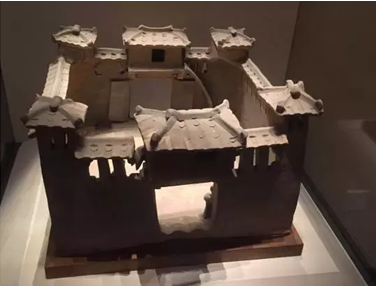
The Han Chinese meanwhile were also known to have practicedChemical Warfare amongst many other developments in the fields of militarytechnology.
Around the year 178 AD for example in order to suppress apeasant rebellion, the Chinese had horse drawn chariots manoeuvre around theopposing enemy army carrying bellows (a device that furnishes blasts of air),which was then used to pump calcium oxide (CaO), or burnt lime at the saidhostile forces.
The Imperial Army was also purported to have used incendiaryrags to rout the enemy, by tying them to the tails of their stallions whichthen acted to terrify them into charging towards the enemy lines, subsequentlydisrupting their formations and in the process acting to make the rebelsvulnerable to an Imperial charge.
With regards to siege equipment on the other hand, the Chinesewere known to have used the Traction Trebuchet, and though they did not inventit themselves managed to develop it to unbelievable standards during the reignof the Han Empire.,
Caltrops, were also known to have been utilized by the HanChinese also in addition. Made from iron primarily, the caltraps or as theywere known as in Chinese, the anti-cavalry pikes (拒马鎗) were an arrayof long ranged weapons (not necessarily spears), which were put up together ona wooden rack and were deployed en masse all over the paths leading to and fromgates, streets, paths and outside the walls of fortresses, in order to halt theadvance of the an enemy cavalry force. They are seen below as follows:
汉朝人据传还实行过化学战,其在军事科技领域还有许多其他进步。
比如,大约在公元178年的时候,为了镇压一场农民起义,汉朝军队乘坐马车、背着风箱(一种可以充气的设备)围绕了敌军,然后用风箱向敌军泵送氧化钙(CaO)-- 也称煅石灰。
据称,汉帝国军队还通过燃烧破布来击溃敌军;将破布绑在公马的尾巴上,然后让马儿冲锋到敌军阵线,这样就打乱了敌军的阵营,从而在冲锋中使叛军处于劣势地位。
另外,至于工程器械方面,据闻中国人还使用了牵引投石机,虽然汉朝本身没有发明牵引投石机,但是却将其发展到了一种难以置信的高度。
另外,铁蒺藜也为汉朝人所用。主要由铁制成,铁蒺藜、或者为中国人所熟知的“拒马枪”,都属于远距武器(不一定是矛),拒马枪被放在一起,置于木制的架子上,并且都被部署在通往大门、街道、小巷和城墙外的通道上,以阻止敌方军队前行。
拒马枪如下图所示:
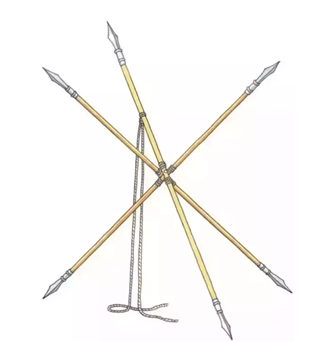
The average Han Infantryman meanwhile, came equipped with fouritems which allowed him to emerge victorious on the battlefields: a Jian, a Ji,Fishscale or Lamellar armour (both were utilized at Han China’s heightsequally), and was also accompanied with by a Gourd Shaped Shield for defensivemeasures.
The Dao was the average infantryman’s sword. Singled handed andsingle edged, was 1.12 m long and made of steel rather than bronze as swordswere first made of in the earliest part of the Han Dynasty. The Dao was madethrough “folding and forging” techniques which acted to improve the quality andstrength of the steel, by minimizing impurities and spreading the carboncontent evenly throughout the aforementioned material.
Because of its length, the users of such weapons were forced toslice rather than stab, much unlike a Roman Gladius. Naturally, it was found tobe more effective when used by the Imperial Cavalry, rather than withinfantryman. It was also a vast improvement from the double-edged Jian whichcame before, and was said to have only taken a week to master, as opposed tothe Jian which took months.
A reproduction of a Han Era Dao:
同时,普通汉朝步兵通常装备了4件装备,这四件装备是战场的制胜法宝:一把剑、一把戟、一件鳞甲或胄甲(二者在汉朝都有使用)、另外还有一件葫芦型的盾牌用于防御。
“刀”,也就是普通步兵的剑。单手握持,只有一测带有刀刃,长度为1.12米,由钢制成,而汉朝最初所用的剑是由青铜制成的。刀是通过“折叠锻打”工艺制成。通过最大限度的去除杂质、并使整个剑胚中碳含量均匀分布,目的是为了提高钢的质量和强度。
由于其长度的原因,持刀者被迫挥刀切削而不是用来戳刺,这与罗马短剑大相庭径。自然的,骑兵用刀作战更加有效,而不是步兵。相对于之前的双刃剑,汉刀是一项巨大的进步,据说只需一周时间便可掌握,而剑需要一个月才能掌握。
一把复制的汉刀:
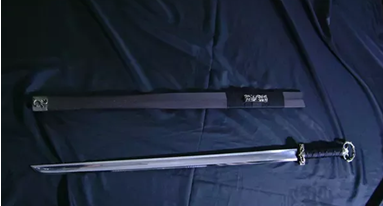
The Ji (Halberd), was a common infantry weapon meanwhile whichcombined a dagger axe with a spear (the cavalry used it as well). It was veryeffective. The Halberd was an especially long spear which came attached with ahook. You could thrust and stab whilst also using it to hook onto the enemy’sleg and pull back to dismember it completely or at least severely cripple it.
Because of the Ji’s length, you could safely kill dozens ofenemies at a very safe distance. It could of course also be used as a longrange double handed axe. Two variants of it are seen below as follows:
戟(Halberd)是一种普通的步兵武器,配有一把匕首斧和一把矛(骑兵叶有使用)。这种武器十分有效。戟是一种特殊的长矛,并附有一个钩子。你可以用它来戳刺;也可以用它勾住敌人的腿,然后将其拖回,从而砍断敌人的手脚,或者至少可使敌人严重伤残。
由于戟很长,在安全距离内,你便可轻松杀死几十个敌人。它当然也可以用作远程战斧。以下是戟的两种不同变体:
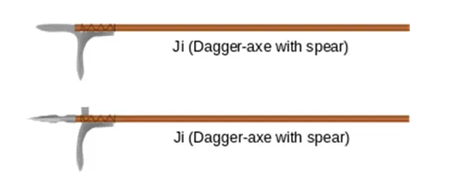
Lamellar Armour meanwhile, was made out of hundreds of smalloverlapping metal and or leather plates laced together, to make a flexible andlight coat of armour. Coat of plates consisted of hundreds of smallnon-overlapping metal or leather plates stitched or riveted together. Thoughoffering much less protection than the legionnaire’s LoricaSegmentata, the Haninfantryman’s armour was much lighter allowing the soldier to move faster andtire out at a slower rate.
Lamellar armour dating back to the Han Wudi Era (141–87 BC)during China’s campaigns against the Xiongnu Empire (Source:HanDynasty Armor):
还有就是薄片胄甲,是由数百个重叠在一起的金属或皮革板制成的盔甲,灵活而轻便。此种胄甲由数百个不重叠的金属或皮革板拼接或铆接在一起制成。虽然相对于罗马的LoricaSegmentata盔甲,其提供的防护要少得多,但这种汉朝步兵盔甲更轻便,这使得士兵能够以更快的速度移动,并且没那么容易疲惫。
可追溯至汉武帝时代--汉匈之战期间(公元前141~87年)的薄片胄甲(资料来源:《汉代盔甲》):
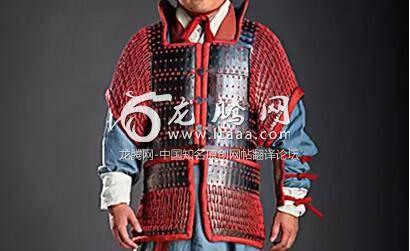
Apart from Lamellar armour, Fish scale cuirasses were alsoutilized by the Han Chinese. Much like its Lamellar variants, Fish scale armourwere also made up of many individual plates which were tied to one another,held by the backing of a cloth or leather in overlapping rows. This particularone below dated back to the Early Han Era:
除了薄片胄甲以外,鳞甲也为汉朝人所用。与胄甲类似,鳞甲也由许多单独的板片彼此相连制作而成,由一排排重叠的布料或皮革的作为里衬。以下这件鳞甲可追溯至西汉时期:

And lastly was the Han Infantry’s Gourd Shaped Shield. Though itpales in comparison to the Roman Scutum, as is self-evident the shield wasextremely small and offers minimal protection to its user. On the other hand,the small shield offered more maneuverability than the scutum whilst offeringsome form of protection against arrows. In addition, it was also much lighterthan the scutum, thus you could use it to offset an enemy’s balance via a swiftblow to the head.
A Gourd Shaped Shield as seen below, dated back to the Han Era:
最后就是汉朝步兵的葫芦形盾牌了。虽然与罗马盾相比,它显得苍白无力,这是很显然的,因为这种盾牌非常小,只能对使用者提供最低限度的保护。但另一方面,小型盾牌提供了比盾牌更多的可操作性,同时一定程度上还能抵御弓箭射击。另外,它比罗马盾轻便得多,所以你可以用它猛击敌人的头部,从而使敌人失去平衡。
以下所示为一块葫芦形盾牌,可追溯至汉朝时期:
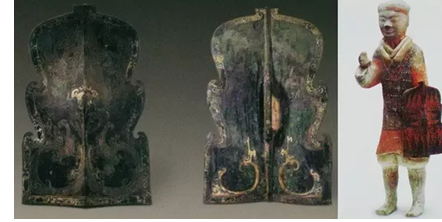
Verdict: The Roman Empire would for sure have been much more advancedthan their Han Chinese counterparts with regards to military technology. But itshould be noted that military technologies were only made to fit with thecircumstances of the time.
For example, whilst LoricaSegmentata was superior to theLamellar armour of the Han, it would not have been wise for the Chinese toadopt a similar set of cuirasses, since they were up against the Horse Nomadsof the North, who went to war on horseback and used bow and arrow to gain acomparative advantage over the Han Chinese. As such a 9kg suit of armour wouldbe a liability to the Han, rather than an asset. Nonetheless, for the purposesof the comparison, the Romans win the last point. Rome and Han: 7 all.
结论
在军事技术方面,罗马帝国肯定比汉朝同行先进得多,但应当指出的是,军事技术只是为了适应当时的战场环境。
比如,罗马人的LoricaSegmentata盔甲要优于汉朝人的薄片胄甲,中国人采用类似护胸甲的装备是不太明智的,因为他们要对付北方的骑马游牧民族,游牧民族是骑马作战的,他们使用用弓和箭,相对来说处于优势地位。因此,像这样的一套9公斤装甲,对汉朝士兵来说是一种负担,而不是资产。为了一分高下的目的,此轮罗马得一分。罗马VS汉朝,比分为7:7.
Conclusion
As should be quite obvious by now, the Han and Romans wereadvanced on a similar scale to one another. At last, such a contention whichhas long been asserted all over the Internet has now (hopefully) been proven atlast.
It would seem that the Romans were more advanced than theirChinese counterparts in the fields of Metallurgy, Medicine, Military Technologyand also slightly when it came to Civil and Structural Engineering.
The Chinese in contrast were more advanced than their Romancounterparts when it came to the fields of Agriculture, Astronomy, Aeronauticsand Mathematics.
The two peer empires meanwhile were equals in the fields of Hydraulics and Mechanics, and Materials Engineering.
The author is forced to conclude as such, that the two great fathers of Western and Chinese civilization, Rome and Han respectively were approximately equal with regards to technological advancement.
总结
现在结果已经很明显了,汉朝与罗马的先进程度大致相当,最后,在互联网上长期存在的这种争论现在(希望吧)终于得到证实。
我们可以看出,罗马人似乎在冶金、医药、军事技术上比汉朝先进,同时在土木和结构工程上比汉朝领先一丢丢。
而汉朝人在农业、天文学、航空学以及数学领域比罗马人先进。
在水力学和材料工程领域,两个同时代帝国的水平是相当的。
作者被迫为西方文明和中国文明的两位祖师爷做了一个总结,结果是罗马和汉朝在科技进步方面大致相当。
DaniilKozhemiachenko (Даниил Кожемяченко), studied history and read sources forfun
Updated Oct 6,2015 · Upvotedby Joe Lonsdale, GP at 8VC; Co-Founder of Palantir,Addepar, Opengov, Affinity and Formation 8.
Thanks for the A2A.
First thing to mention is that technological progress of ancient China is oftenassociated with so called FourGreat Inventions, first of which was made in Han period (i.e. no later than 3rd centuryAD). If we try to compare level of technology in Rome (in 2nd — 3rd centuriesAD), which was, in fact Greek technology, as most of the inventors, engineersand «scientists» were Greeks, and that of China we will find, that paper andporcelain were almost sole things Chinese could produce and Romans could not(they used parchment and papyrus instead).
谢邀首先要提到的是,中国古代的科技进步往往与所谓的四大发明有关,而四大发明的第一项就是产生于汉朝(公元3世纪之前),如果我们试图将之与罗马(公元2~3世纪)的科技相比,实际上那是希腊的技术,因为大多数发明家、工程师或者科学家都是希腊人。我们会发现,几乎只有纸张和瓷器是罗马人不能生产而中国人能生产的东西(罗马人用羊皮纸和纸莎草纸代替)。
There were also many things that both of the nations could produce, build or do(e.g., roads, city plumbing, steel of various quality, «artillery»*, crossbows**and so on) which had pretty much the same properties.有很多东西是两个国家都能生产的、建造的(比如,道路、城市管道、各种质量的钢、大炮(应该是弩炮吧?)、弩等等),他们几乎具有相同的属性。
However, there were things which Chinese (in contrast to Romans) couldn'tproduce: treadmill crane, armor of substantial quality (in fact, almost theonly thing they forged well were swords, while their helmets or body armor wererather primitive), cement, plastic surgery (we have a treatise from Galenthereon) and surgical instruments.Nevertheless, although Romans could possess a bit more technologies thanChinese the products of both civilizations were on almost the same level: bothwere able to build big palaces, big walls or fortresses, supply their citiesand fields with water, cure the ill, produce massive amounts of weaponry ofsubstantial (at least superior to their enemies') quality and so on..
然而,存在着中国人无法生产而罗马人可以生产的东西:起重机、结实的装甲(实际上,他们能锻造的唯一东西只有是剑,而他们的头盔或铠甲相当原始)、水泥、整形手术(盖伦有一篇论文)以及手术器械。
虽然罗马人拥有比中国人更多的技术,但这两个文明的产品几乎处于同一水平:两者都能建造大型宫殿、大型城墙或堡垒、为城市和农田提供供水、治疗疾病、生产大量优质的武器装备(至少比他们的敌人要优越)等等。
Jay Liu, I've been told I'm Chinese...
Answered Oct 3,2015
Thanks for the A2A
The Romans and Han Chinese were advanced in different fields, it's hard to saywho was "more" advanced.Romans were relatively advanced in:
· Civic and military engineering
· Military organization
· Metal forging techniques, the Romans forged very high quality steel
谢邀
罗马与汉朝的科技都很先进,但是所专注的领域不同,很难说谁更先进一些。
罗马的先进之处在于:
· 土木和军事工程
· 军事组织
· 金属锻造技术,罗马人可以锻造从非常高质量的钢
Han China was relatively advanced in:
· Agricultural technology, especially in irrigation engineering. Growing rice is more an exercise in engineering than agriculture.
· Civil organization: Han China had a modern, centralized, meritocraticbureaucracy, dwarfing the Roman Imperial administration in both size andcomplexity
· Metal casting techniques: Chinese could cast iron to a far higher quality thanthe Romans could, this allowed the Han to equip far larger armies.
汉朝的先进之处在于:
· 农业技术,特别是灌溉工程。种植水稻更像是一项工程行为而不是农业行为· 民间组织:汉人拥有一个现代的、集权的、精英式的官僚机构,在规模和复杂性上使罗马帝国相形见绌。
· 金属铸造技术:中国人的铸铁质量要比罗马人高得多,这使汉朝装备了更大规模的军队。
I'm not going to try and make comparisons between the ClassicalGraeco-Roman philosophical traditions vs. Confucianism. There's no way toobjectively state which is "better". Both survive in some formin the modern world.
我不会试图将经典古希腊--罗马哲学传统与儒家思想相比较。因为根本无法客观说明哪一方更好。这二者都在现代社会中以某种形式存在着。
Karen Carr, Assoc. Professor Emerita,History, Portland State University. http://quatr.us
Answered Oct 31, 2016
This is really the wrong question, because the world center oftechnology in the first centuries CE was neither China nor Rome, but CentralAsia and India. To answer your question, though, I think they’re pretty even.
这其实是一个错误的问题,因为在世纪之初,世界技术中心不是中国也不是罗马,而是中亚和印度。但要如果一定要回答你的问题,我认为他们的水平是相当的。
Things Rome had that China didn’t:
Glass, and especially blown glass. Wool and linen. The lateensail, a triangular sail that made it easier to tack sailboats into the wind.Better oil lamps. Mold-made pottery. The idea that the earth might go aroundthe sun, and a good idea of how big around the earth was. Concrete, and the useof concrete for barrel vaults and domes. Better trigonometry than China. Bettersurgical techniques including removing dead fetuses so the mother didn’t die,and eye operations for trachoma. Slightly more experience with human and animaldissection, and therefore a somewhat better understanding of how human bodiesworked. Opium for anesthesia. The camera obscura.
罗马有而中国没有的东西:
玻璃,特别是吹制玻璃、羊毛和亚麻布、三角帆(一种三角形的帆,使帆船更容易迎风)、更好的油灯、用模具制造的陶器、地球可能绕太阳旋转的想法,地球有多大的想法、混泥土,以及用混泥土建造拱顶和圆顶、三角函数比中国厉害、更好的手术技术,包括去除死胎,保住母亲的性命和眼科手术治疗沙眼、人类和动物解剖的经验略多,因此更了解人体如何运作、用鸦片来麻醉、相机暗箱。
Things China had that Rome didn’t:
Gunpowder, paper, silk and hemp cloth, a cure for malaria,magnetic compasses, the crossbow, the double piston box bellows (helpful formaking hot fires to make steel), the water-powered box bellows, windmills, amore efficient system of writing numbers enabling them to solve simultaneousequations.
中国有而罗马没有的东西:
火药、纸张、丝绸和麻布、治疗疟疾、罗盘、弩、双活塞风箱(有助于产生热火用以制造钢铁),水力驱动风箱、风车、更有效的数字书写系统,能解决联立方程式。
Things Central Asia had that Rome and China didn’t:
High quality crucible steel, cotton, sugar, the recurve bow,better horses, the numbers we call “Arabic numerals”, mathematical theories oninfinity and probability, the idea of zero, tables of trigonometry sines,plastic surgery for facial reconstruction, cataract surgery, charcoal filtersfor clean water, the use of citrons to cure scurvy (Vitamin C deficiency).
中亚有而中国罗马没有的东西:
高质量坩埚钢、棉织物、糖、反曲弓、更好的马匹、阿拉伯数字、无穷大和概率的数学理论,零的概念,三角正弦表、面部重建整形手术、白内障手术、木炭净水器、用香橼治愈坏血病(缺乏维C)
But really 1) all of these inventions were important and had tobe combined, in the end, to move technology forward and 2) most of them wereexchanged pretty soon, and people did combine them. By end of the the MiddleAges, Europe had gunpowder, paper, silk, sugar, crossbows, cotton, and steel,Central Asia had opium, and China had cotton, sugar, steel, and lateen sails.China’s lack of experience with glass ended up being a serious handicap indeveloping chemistry and physics experimental equipment, and telescopes,though.
但说真的
1) 所有这些发明都非常重要,最终必须结合起来,从而推动科技的发展。
2) 很多技术很快就会进行互换,最终人们也会将他们结合起来,到中世纪末,欧洲有了火药、纸张、丝绸、糖、弩、棉织物、钢;中亚则有了鸦片;而中国有了棉织物、糖、钢、三角帆。尽管如此,中国对玻璃的制造缺乏经验,最终成为开发化学和物理实验设备和望远镜的严重障碍。
Al Jones
Answered Oct 8,2015
If you add up all of the technologies and scientific knowledgeboth developed/acquired and more importantly, broadly deployed, it's easy tomake a case for the Han and China in general being hundreds of years moreadvanced than the Roman Empire. See Joseph Needham's books on Chinesetech or the comparisons between Chinese, Islamic Middle East, and WesternEuropean advancements in Stanford economic and technologyn historian NathanRosenberg's book "How the West Got Rich".
The Romans were more advanced than commonly given credit for since laterauthors focused on war and politics rather than business, manufacturing,applied sciences, nutrition, surgical care, public health/water treatment,transportation networks, trade networks, and surrounding civilizations' techtransfers (Egypt, Carthage, Greece, Persia, Spain, Gaul, the Baltic, NorthAfrica, India, etc.) that China drew on sophisticated neighbors as well(Thailand, Cambodia, Korea, India, Mongolia, and the many nations nowconsolidated into modern China.)
Roman history's always just been far more accessible to Western scholars whoused to be educated enough to read Classical Latin well into the 20th Centuryand the easiest books to find in most libraries dominate theories and consensusknowledge for centuries.如果你把所有自行开发或者外部获得的技术、科学知识加起来,而且从(科学技术)使用的广泛程度的角度来看,那么你将很容易看出,汉朝比罗马要先进数百年。参见Joseph Needham关于中国科技的书籍,或参见斯坦福大学经济和技术史学家Nathan Rosenberg的书籍--《西方是如何变得富有的》,这本书将了中国、中东伊斯兰、西欧的科技进行了对比。
后面的答主对罗马有点过誉,因为后面的答主更关注战争和政治,而不是商业、制造业、应用科学、营养学、手术护理、公共卫生/水处理、交通网络、贸易网络、周边文明的技术转让(比如埃及、迦太基、希腊、波斯、西班牙、高卢、波罗的海、北非、印度等),中国也吸引了许多不同的邻国(比如泰国、柬埔寨、朝鲜、印度、蒙古,以及其他许多已经并入现代中国的国家)
罗马历史对于西方学者来说,往往更容易获得,因为西方学者受到了足够的教育,从而使他们在20世纪也能阅读古典拉丁文,而且大多数图书馆里最容易找到的书籍,已经主宰理论和共识数百年了。
Kurt Scholz, historian of science and technology
Updated Aug 28,2015
That is comparing apples and oranges. Each had its owntechnocomplex. There is no metric of being more advanced. However, advancementshappened in different fields due to different political systems.
Han China had a major interest in improved farming and built technology in thisfield that outlasted their rule. The same can be said of Roman concrete tobuild up their magnificient cities with fresh water supply and centers ofculture and entertainment.这就跟那苹果虎橘子比较一样。各有各的技术复杂性。没有谁比谁更高级的标准。但是,由于政治制度的不同,他们各自在不同领域有不同进步。
汉代中国对改善农业和建立这一领域的技术非常感兴趣,从而使得(汉朝的)统治时间很长。对于罗马来说也是一样,他们采用混泥土来建造宏伟的城市,并辅以淡水供应和文化娱乐中心。
Robert Johnston, I know technical.history.
Answered Oct 4,2015
I'm reading "The three kingdoms" which deals with theevents that lead to the downfall of the Han dynasty. It seems to me that theEmpire in China was much more loosely organised than the Roman which althoughnot immune to internal tension would have not fractured in the same way.
As far as technology is concerned perhaps China had a slight edge. Certainly,the West wanted the goods, hence the silk road. Inventions also tended to flowEast to. West rather than the other way around.我正在读《三国》,这段时期所发生的事导致了汉朝的垮台。在我看来,在中国,其帝国的组织性比罗马要松散得多,尽管罗马不能免疫内部紧张的影响,但不会以与中国一样的方式分裂。
就技术而言,中国可能略有优势。这是必然的,西方想要通过丝绸之路进口货物,技术发明也倾向于由东向西传播而不是由其他的方式传播。
Margot Darby, Former journalist for InfoWorld.
Answered Aug 30,2015
Roman Empire, definitely, because of itsmany legacies which have stood the test of time. Both Ancient Rome and AncientCathay had highly developed statecraft, and they were arguably equivalent inmatters of technics. But we are writing this in Roman characters usedthroughout the world, on technology developed by Western European peoples witha culture derived in large part from the Christian civilization of the HighMiddle Ages and Ancient Rome. Old Cathay has nothing to compare.
当然是罗马帝国了,因为它的许多遗产经受了时间的考验。古罗马和古中国都有高度发达的治国方略,所以说他们在技术上来说是大致相等的。但是我们正在采用在世界广泛流传的罗马字符写答案,而且是利用西欧人发明的科技来写答案,而西欧文明大部分衍生自中世纪中期基督教文明和古罗马。古代中国没有什么可比性。
Gwydion Madawc Williams, Read a lot about history, and notesome general patterns.
Answered May 5,2014
The Roman Empire and Han Dynasty Empire in China were aboutequal. China had silk, but the abacus is thought to have evolved from theRoman counting board.
罗马帝国与中国汉朝大致相当吧。中国有丝绸,但算盘算是从罗马计数板发展而来。
Weijia Deng, a guy who knows Chinese and a littleJapanese
Answered Jan 8
There are two kinds of technologies, those summarized fromexperiences, and those deducted from theories. For the first kind, it is hardto tell, while for the second kind, Roman Empire is far more better. Mostphenomena cannot be explained reasonably via theories back then, but it is theRoman way of describing world leads to modern science.
有两种技术,一种从经验中得来,另一种则是从理论中得来。对于第一种,很难说;然而对于第二种,罗马帝国就要好得多了。因为当时大多数现象都无法通过理论进行合理解释,但是,是通过采用罗马的方法,才导致了现代科技(的进步)。
-----------完-----------
版权声明
我们致力于传递世界各地老百姓最真实、最直接、最详尽的对中国的看法
【版权与免责声明】如发现内容存在版权问题,烦请提供相关信息发邮件,
我们将及时沟通与处理。本站内容除非来源注明五毛网,否则均为网友转载,涉及言论、版权与本站无关。
本文仅代表作者观点,不代表本站立场。
本文来自网络,如有侵权及时联系本网站。
-
1
Why do most people who have a positive view of China have been to ...
- 2
- 3
- 4
- 5
- 6
- 7
- 8
- 9
- 10
-
1
Why do most people who have a positive view of China have been to ...
- 2
- 3
- 4
- 5
- 6
- 7
- 8
- 9
- 10










